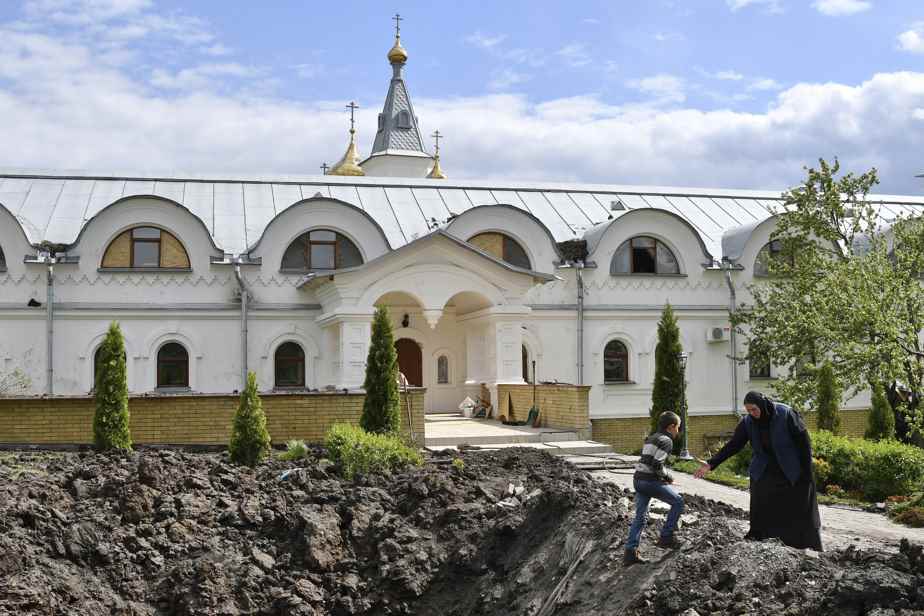Since 2014, the war has caused a triple rupture between Russia and Ukraine, ending political, economic and cultural relations between two states. The latest war, which began on February 24, 2022, also caused a veritable earthquake between the Orthodox Churches in two countries, and even within the communion of Orthodox Churches on a world scale.
Posted at 1:00 p.m.
In Ukraine, Orthodoxy is divided mainly between two Orthodox Churches now opposed to each other for much more political than theological reasons. The first, the Ukrainian Orthodox Church, is the Ukrainian branch of the Moscow Patriarchate. Placed under the jurisdiction of the Patriarch of Moscow Kirill, it brings together some 5 million faithful. The second is the Ukrainian Orthodox Church, called autocephalous or independent. It has around 15 million followers. It should be noted that among the 15 so-called autocephalous Orthodox Churches spread throughout the world, the Ukrainian Orthodox Church is the second largest, behind that of Moscow, with its 100 million faithful. His independent canonical status was recognized by Patriarch Bartolomeus IerPrimate of the Patriarchate of Constantinople, headquartered in Istanbul.
It is by decree (tomos) granted by the latter that the Orthodox Church of Ukraine acceded to autocephaly in 2019. Being placed since 1686 under the jurisdiction of the Moscow Patriarchate, the Orthodox Church in Ukraine therefore only acquired its true autonomy very recently. This emancipation from the Moscow patriarchate must be seen as a direct influence of the independence of the self-proclaimed Ukrainian state in 1991, following the disintegration of the Soviet Union.
In the words of Petro Poroshenko, then President of Ukraine in 2018, the emancipation of the Orthodox Church of Ukraine from the tutelage of the Moscow Patriarchate put an end to “the imperial illusion and [aux] chauvinist fantasies of Moscow”.
For Patriarch Kirill, the highest religious authority in Russia, the recognition of the autocephaly of the Church of Ukraine places the faithful of this territory on the side of schism. So he categorically rejected the decision of the Patriarchate of Constantinople, proclaiming that “all the forces of evil are united to tear the Ukrainian Church from the unified Russian Orthodox Church”.. The Kremlin’s reaction and language aligned with Kirill’s words. For her part, the spokeswoman for the Russian Foreign Ministry, Maria Zakharova, who is still in place, then declared in a somewhat prophetic tone: “It is a dividing line, a new manifestation of a colossal split in within Ukrainian society. The situation will end in a global catastrophe. The year 2014 taught nothing. »
“Forces of Evil”
Retroactively, it appears that for Moscow, the red line had just been crossed by the Ukrainian State and its State Church. From 2019, Russian military intervention covering the whole of Ukrainian territory was then not only conceivable, but also perfectly justified in the name of holy war against the forces of evil. In his homily delivered on February 27, 2022, Patriarch Kirill will indeed qualify as “forces of evil” all those opposing the unity of the two Churches. In the same vein, President Putin and his spokesman Dimitri Peskov went even further by referring to these forces of evil as the Ukrainian Nazis.
The denial of the independence and sovereignty of Ukraine by Russian military aggression, since February 24, 2022, thus goes hand in hand with the denial of the autocephaly of the Ukrainian Church.

PHOTO OLEG VAROV, ASSOCIATED PRESS
Patriarch Kirill, whom Pope Francis called “President Putin’s choir boy”.
It was essentially the risk of losing his influence over the approximately 15 million Orthodox faithful in Ukraine that led Kirill to completely align himself with Putin’s political and military aims vis-à-vis Ukraine.
While Putin is aiming for the submission of the Ukrainian state, Patriarch Kirill is seeking to regain control of the Autocephalous Church of Ukraine by forcing its reintegration into the Moscow Patriarchate.
Here, the alliance of politics and religion, forged in 2018 and 2019 in order to quell any desire for independence on the Ukrainian side, is a proven tactic that has enabled Putin to regain Belarus.
In short, the Patriarch of Moscow’s unconditional support for war enabled the political power to launch its military intervention in Ukraine, knowing that the vast majority of the Russian faithful would follow Kirill’s exhortations by refraining from participating in the public demonstrations against the war. The line of conduct enacted by Patriarch Kirill, together with the censorship of unofficial media and the all-out propaganda of the regime in place, explains the passivity of a large part of Russian civil society in the face of the current war, even its unconditional support for Putin’s regime.
Admittedly, the attitude of Patriarch Kirill and his positions are the subject of criticism even within the Orthodox Churches. Closer to home, Pope Francis did not go out of his way by calling Kirill “President Putin’s altar boy”. The Moscow Patriarchate considered the pope’s remarks “regrettable”. In response, the meeting between Patriarch Kirill and the Pope, scheduled for June 2022, was by mutual agreement postponed to an unspecified date.

